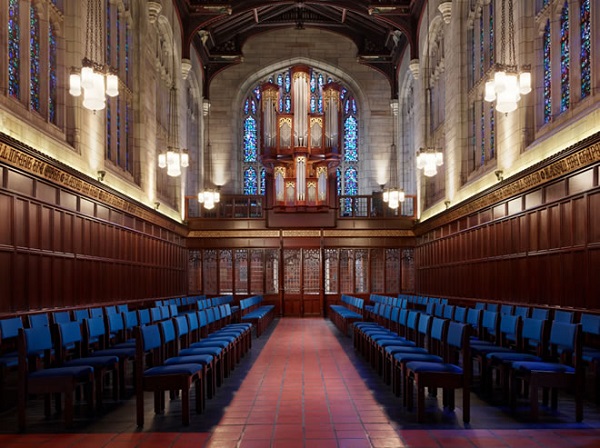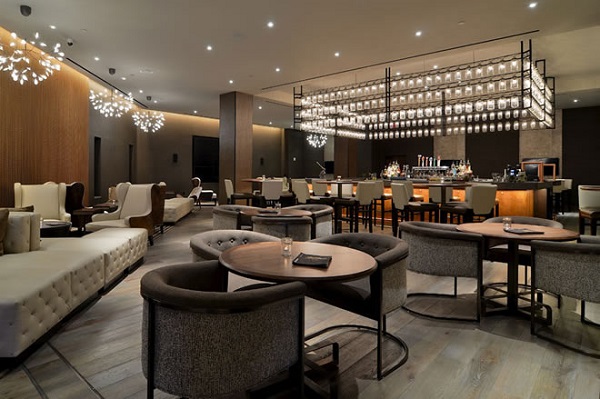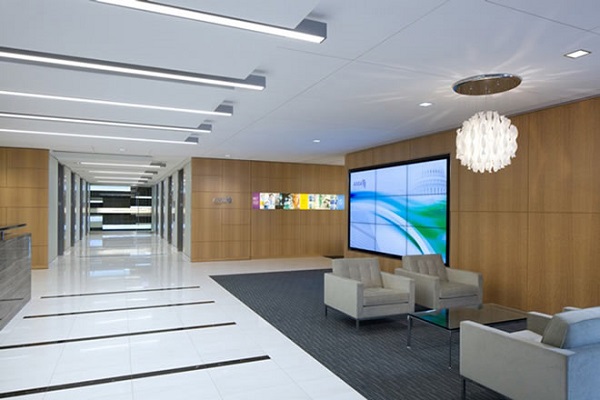Anne Kustner Haser, president and design principal at Anne Kustner Lighting Design (AKLD) in Evanston, Illinois started her professional career as a graphic designer, but quickly fell out of love with graphic design in favor of lighting design. Perhaps this decision was influenced by the way some photographers she worked with utilized lighting to instill excitement into an otherwise ordinary product. Or, maybe it was an instinctive aptitude that Anne displayed while arranging lighting throughout her house as a young teenager. Even more so, it could have been the influence of her supportive family and especially her encouraging father, who himself was involved in electrical engineering. Since that fateful decision, and after opening her own lighting design studio 21 years ago, Anne has created stunning lighting environments for a unique blend of commercial, hospitality, and high-end residential clients that allow their individual personalities to shine through.
What are some differences in your residential and commercial projects when it comes to client interactions and expectations, and also design?
They are definitely two different animals. With commercial, it’s usually more straightforward, with a clear direction up front and a good design team that relies on our expertise. But, there’s the reality of a budget, and the potential of having to modify the design to save money. So at the end of the day, sometimes the design is still very strong, and sometimes it’s lacking due to budgets. Whereas in high-end residential, budgets are usually less of an imposition. You can design it and build in more layers of lighting, and some of the most intricate things we have done are on high-end residential that would not last in commercial projects, so sometimes you can do more amazing things in high-end residences. But the downside can be unexpected client changes and sometimes even communication among the project team. Sometimes interior designers and architects aren’t used to sharing information with a lighting designer, so a finish change, like changing white marble to black granite, isn’t shared, but can make a significant difference to the lighting performance and design.
 |
|
New Faith Baptist Church, Matteson, IL
Harding Partners, Architects
(All Photo Courtesy of Anne Kustner Lighting Design via Philips)
|
How do you use lighting to convey a message or emphasize a brand?
We try to look at what the client, architect and interior designer are envisioning. It could be that an architectural office wants to be seen as eco-friendly, or a hospitality establishment wants to take their brand to a new level, or a retail store wants their goods to look more sexy and amazing. Or in high-end residential, it could be highlighting architecture, furnishings or artwork. In all of those cases, we want to light the most special things, in the most successful way. Sometimes we highlight a bit of this and we let the lighting fall off of that, always being selective as what to light. We also take into account the style. A traditional project in any realm relies on traditional fixtures like chandeliers, sconces and table lamps as part of the vocabulary, whereas in contemporary styles, the design can be very clean, where we emphasize the architecture, going very minimal yet still with enough light. Each project is a different formula, we use the same paint brushes, so to speak. But each end result is a different combination of how we apply those techniques.
What are the lighting challenges that you face?
These days, we need to vet every LED fixture that we spec. Back in the day, you had a good PAR38 downlight, and it was your go-to. It was one of the tools in your toolbox, and you knew all of the tools in there. Now with LED technology, your toolbox is ever-changing; it’s fluid. So we must see and dim every LED source, look at it on the finishes and so on. It’s a lot more review, and not as easy to value engineer. We had to value engineer a project for a restaurant a number of years ago, where a linear LED luminaire was used under a rough-grained natural wood bar front. The client said they were changing out this LED luminaire that we specified to a different product. They changed it out and dimmed it, and it shifted green! We could see it from a distance, it was awful. Even something like putting acrylic or a sleeve around the linear LED means that the color might shift the color temperature cooler. We’re also seeing that different LEDs have different dimming curves. Some dim similar to an incandescent, some are slightly different, some are totally different and there’s no consistency. LED technology is evolving so quickly, and there aren’t standards yet. So a lamp can be 3000K, but you can look at 3000K lamps from five manufacturers and they’re all different because of all the variations to white light. That makes tunable white really nice, because we can shift it to be warmer or cooler depending on what the other players are, but there is a cost involved.
 |
|
University of Chicago, Bond Chapel, Chicago, IL
Woodhouse Tinucci Architects
|
How do you think lighting and lighting design will change in the next 3-5 years?
The good news is that it’s evolving. The bad news is that it’s evolving. I’ve been using LEDs for over a dozen years. I keep saying that in 5 years, everything will settle down. I’ve said that for the past 12 years, and I haven’t seen any indication that we’re close to that. With that said, LEDs will continue to get smaller, brighter, and more efficacious. They’ll look better, we’ll get more reliable dimming, less flicker and strobing, and the prices will come down. With dimming, we’re getting dim to dark, or dim to black, but each time we’re dealing with a dimming system, we have to test fixtures if they haven’t been tested with that system. In hospitality and high-end residential, you must dim lower than 1% because the eye adjusts to them after 20 minutes, especially when you have many layers of light. Eventually, I hope there will be more standards. We all want that. Also, there are opportunities to use LEDs in more creative form factors that incorporate their unique form; we’ll be able to work LEDs into architectural materials and building forms, where we can be even more creative.
Describe some memorable projects that you worked on.
We’re working on a great project now, it’s not done yet, but it took a lot of coordination with the architect, interior designer and contractors to get everything placed just right and working together without over lighting. That’s my favorite thing – not over lighting. Gone are the days of big blankets of light and even illumination; that’s boring. Now, it’s, “let’s light this, wash that, highlight this, and it’s done.” It’s very dramatic, and energy-efficient, and you can knock their socks off. It’s about editing the design; editing it to where it really pops. Some of the contemporary high-end residential projects we’ve done have been very rewarding because these clients get it, and they’re very sophisticated, and the designers are sophisticated, and the results are stunning – sleek, minimal and edited. I don’t hang my hat on any particular project. We’ve worked with very talented architects, and for me, it’s not necessarily only the design that makes a certain project memorable, but it’s also the team. Where there’s a great architect, a great interior designer, and a great client with the budget and the confidence to say ‘do it’, that is memorable for me. You can be an excellent designer; but without that right mix it doesn’t matter how creative you are, it’s just not going to happen. I am blessed, really more so for the teams we’ve worked on, and love working with, more so than any one project.
 |
|
Loews Vanderbilt Hotel, Nashville, TN
Rule Joy trammell + Rubi, LLC, Architects
Simeone Deary Design Group, Interior Design
|
What is important for the general public to understand about LED technology, and on the other hand, what is important for LED lighting manufacturers to understand about design?
That’s a big one. Some people think a light bulb is a light bulb because that is the way that they are marketed. And I think with LED, similar to when compact fluorescents came out, that it’s the same but again…different. It’s a different type of animal. We now have all these complexities and options, like a range of color temperatures, where some look good, and some look not so great. There are also huge differences as far as dimming – you can get an LED bulb that dims and the same, similar bulb that doesn’t. That being said, there’s so much value with LEDs in terms of the energy consumption going down, and reducing air conditioning loads, especially in warmer climates. For commercial projects, we use pretty much all LED now, but in residential, we haven’t been able to get all the things we’re used to…yet. For example, with an MR16 for accent lighting, with LEDs, we can’t get the beam spreads down as small as we want, and we can’t get a smooth dimming curve that also holds the color rendering when it’s dimmed really deep. We have found that some LEDs, when dimmed like you would use in hospitality, look hollow, or unsaturated or grey. It makes people look ghostly, and the space isn’t appealing. We have also seen some light sources that, when dimmed, keep a good saturation and look decent all the way down. We’ll continue to stay tuned, because LED technology will get better and better.
On the manufacturing side, I think with LEDs, it’s two-fold. On one hand, there are millions upon millions of existing fixtures out there that can still be used, so we need the ability to retrofit LED technologies into these fixtures. But on the other hand, LEDs come in totally different form factors that should be explored, so manufacturers need to think outside the box. You can be creative and incorporate LED’s unique form factors on a totally different level. So I’ve given you two different and conflicting answers, one I want manufacturers to make LEDs fit into something it’s not meant to fit into to help us with existing fixtures, and also take it to the next level. There are just so many things you can do with these form factors.
Speaking of tunable white, could you discuss the role of dynamic lighting in your designs?
Tunable white is a great tool to be able to adjust the light to the perfect white for the project. Since Kelvin temperature do not always a totally accurately describe the white light anymore, being able to tune the white helps. We are also seeing new certifications that suggest lighting for circadian rhythms. Having the tunable white technology is a great tool in your toolbox, as long as it can fit in the budget.
 |
|
American Medical Association, Chicago, IL
Interior Architects
|
What are your clients are motivated by today? What’s important to them when it comes to lighting?
For commercial clients, I’m thinking of a couple office spaces that we’re working on now, where they want something fresh, new, and sustainable. They want something dynamic and also want to take advantage of LEDs to have a greener project. For a hospitality project we’re working on, they want to take advantage of the different form factors of LEDs to push the limit, and make it look edgier. There are commercial and residential projects that want a traditional look, but want to take advantage of the energy and reduced maintenance that LED technology has to offer. With energy codes these days, we need to use LEDs. With the, energy codes and daylight harvesting, LEDs are a natural solution because many LED products have inherent dimming capabilities, which make them almost as cost effective as dimmable fluorescents.
Are your designs limited by codes?
I think now we’re over the hump – we can design the way we want to design. The challenge is that it’s one thing to follow a local or national energy code, but now so many more green building certifications are out, where the client and/or architect wants to be 25% to 40% below code. We’re working on a project now where the client wants the lighting power density to be 0.6 watts per square foot or below. We came in over budget, and explained to them that if we had to reduce the amount of LEDs by changing some of the fixtures to fluorescent in order to save money, the wattage would increase over their goal. It’s interesting, because they decided to spend a bit more on the lighting to meet their energy goals. This is the first time that I experienced the energy requirement driving the project that much. Nowadays, LED technology, the energy codes and dimming are all driving up project costs, so lighting is costing more per square foot than architects were traditionally used to. That’s the biggest learning curve for commercial architects and clients right now. We recently completed a few green commercial office projects that work well and look good with a $10 square foot lighting allowance. We see that gone are the days to be green with a $4 per square foot lighting budget.
All photo were provided by Anne Kustner Lighting Design via Philips.















